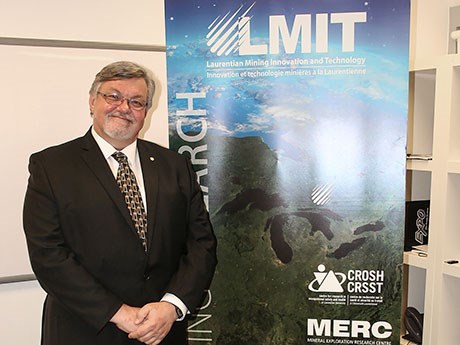Four mining related research centres at Laurentian University have come together to market their capabilities to government and industry.
Laurentian Mining Innovation and Technology (LMIT) brings together the Centre for Research in Occupational Safety and Health (CROSH), the Mineral Exploration Research Centre (MERC), MIRARCO Mining Innovation and the Vale Living With Lakes Centre.
Described as “an overarching structure,” LMIT will serve as a resource for promoting the university’s mining research capabilities.
“The four research centres are all independent units that do great 23work,” said Vic Pakalnis, associate vice-president of LMIT and president and CEO of MIRARCO Mining Innovation. “LMIT is not meant to restrict them. It’s meant to grow the pie. My job is to go after provincial and federal funding, establish partnerships with other universities and countries, and knock on industry doors.”
LMIT will consolidate Laurentian’s stature as a centre of excellence for mining research, said Pakalnis.
“We’re the only university in Canada that has mining as part of its strategic plan and the only university in Ontario that has identified mining as a strategic priority.”
Each of the four research centres has a distinct focus.
CROSH with its focus on occupational health and safety boasts 61 active researchers with expertise in vibration induced injury, traumatic injury prevention, occupational epidemiology, workplace mental health, the health effects of exposure to airborne chemicals and workplace hazards.
MERC has a complement of 66 active researchers, including six post-doctoral fellows, 30 PhDs and 30 Masters students with expertise in geology, geochemistry, geophysics, mineralogy and environmental reclamation.
MIRARCO with 50 active researchers specializes in geohazard assessment and risk mitigation, mining safety and risk management, ventilation, renewable energy and climate adaptation.
The Vale Living With Lakes Centre boasts 75 researchers focusing on a broad range of environmental issues impacting the mining industry.
Laurentian also hosts the Centre for Excellence in Mining Innovation (CEMI), which functions as a research broker, is independent of the university and, therefore, not part of LMIT.
Sudbury and Laurentian are ideally located for mining-related research, said Pakalnis.
“We’re the only university in a city that has 14 mines within its boundaries. CalTech, the University of British Columbia, McGill and Queen’s (University in Kingston, Ontario) can’t compare. There are no mines in Montreal or Kingston. The infrastructure we have in Sudbury is unique. In addition to our mines, we have more than 300 mining suppliers. We can parlay all this into a research and innovation hub.”
Years ago, mining companies had their own research centres, but that’s no longer the case, noted Pakalnis.
“In the 70s and 80s we had the Noranda Research Centre in Montreal and Inco’s Sheridan Park in Toronto. Most major mining companies no longer have large in-house research centres today. It’s a sign of the times. When you’re struggling and trying to conserve cash, in-house research is not something you’re going to invest in.”
Universities are filling that gap, and none are better positioned to do so than Laurentian, according to Pakalnis.
Laurentian’s Goodman School of Mines, which brings together mining engineering, earth sciences and environmental disciplines “is all about education,” said Pakalnis. “LMIT is all about research, and creating a united front to industry and government, so five, 10 people don’t go knocking on the same door.”



